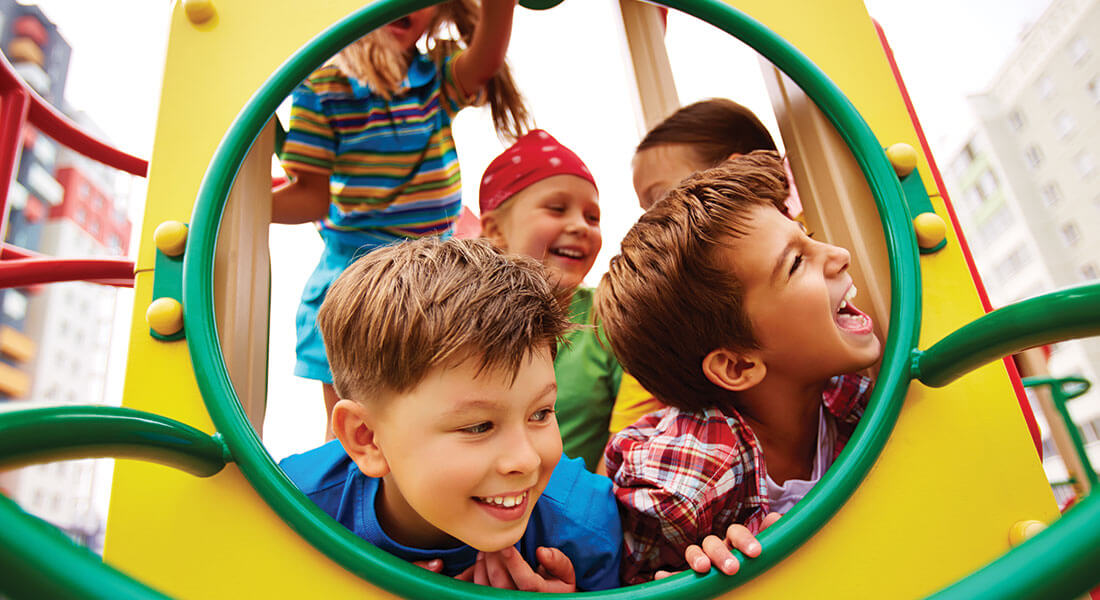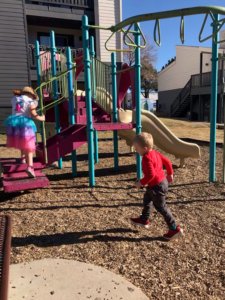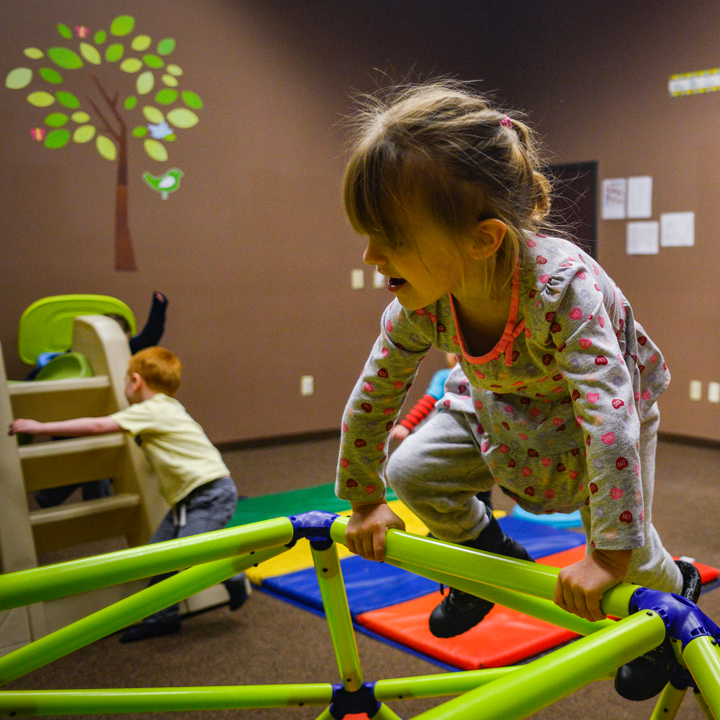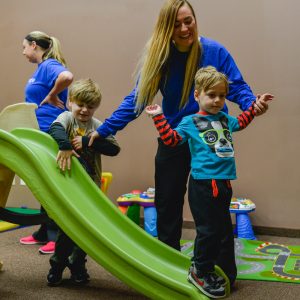Playground Tips for Kids with Autism
August 11, 2021
August 11, 2021

Think back to your childhood. We’re guessing that you have at least one memory from a playground when you were a kid. Trying to swing high enough to reach the sky, meeting a new friend on the monkey bars, going down the slide on your belly (no matter how many times your mom told you not to), or playing hide-and-seek behind a post that couldn’t fully conceal you. For many, parks and playgrounds are where memories are made.
Now that you’re caring for a new generation, those slides and swings may or may not still bring joy. Especially for families of children with autism spectrum disorder (ASD), the playground can either be a blast or a new worry.
For families experiencing either scenario, our Hopebridge clinicians came together to share their top playground tips for kids with autism. Besides offering a world of possibilities for kids to explore, these spaces encourage physical activity, can facilitate pretend play, stimulate the senses and enhance social skills.
Whether you have a goal of increasing entertainment or safety – or both! – on the playground, keep reading to help make the most out of your child’s time at the park.
As with other areas of life, the playground can pose additional challenges for autistic individuals and those with developmental delays or disabilities.
Some areas around the country are recognizing this, like Mesa, Arizona, and creating special spaces to provide people of all abilities the opportunity to play. Mesa is home to the first Parks & Recreation agency in the world to be designated as a Certified Autism Center (CAC), part of which features its adaptive playgrounds, and we’re happy Hopebridge is part of such an inclusive city!
Whether or not there is an adaptive playground near you, here are some of the things that might make going to the park more difficult for families touched by autism:

At Hopebridge, we’ve seen kids struggle with elements of the playground, but we’ve also seen them overcome them and learn to love it. Hopebridge Board Certified Behavior Analyst (BCBA) Akricia Joseph from Georgia remembers watching this happen when she was an RBT Fellow at the Douglasville center—and the child hadn’t even started therapy yet!
“The family came in for her ABA evaluation and I took the daughter to our center’s gym area. She would walk up the ladder for the slide but would not go back down. By the end of the evaluation, her parents walked around for a clinic tour, when she suddenly made her way down the slide. Her dad was so surprised and told us she never goes down the slide!” said Akricia. “Sometimes, children want to use the gym or playground equipment but are a little nervous or aren’t sure how to do it. As part of ABA therapy, we can help introduce them to these new experiences.”
Kids learn through play, so it’s a big piece of autism therapy. As part of our 360 Care model at Hopebridge, our programs are individualized and can combine applied behavior analysis (ABA therapy), occupational therapy, speech therapy and other services to build the skills children need to play.
As part of this, ABA therapy and our other services inherently lead to more fun on the playground and in similar spaces. Center-based autism therapy, like we offer at Hopebridge, can be even more powerful because we are able to incorporate naturalistic teaching. Our clinicians create obstacle courses, use chalk for games of hopscotch, play tag, pull out bikes and scooters, and encourage them to use the equipment on our indoor gyms or outdoor playgrounds.

“Sometimes our kids want to go inside the gym climbing dome and just sit there. Other times they climb all over it,” said Akricia. “As part of our programming, we play alongside them and show them how to play. They often just need a little guidance to get started.”
Seemingly simple games of tag and “Red Light, Green Light” can have a lot of power on the playground and in real life. ABA and speech therapists can use it to teach them to follow directions like “stop” and “go” at the same time. These games also help with children who elope, so the skills also translate to visiting the park.
As part of ABA, therapists work on skills like taking turns, which helps when interacting with others on the playground. ABA and occupational therapists can teach children to use equipment appropriately, such as how to go down a slide rather than walking up, or how to jump on a trampoline by allowing them to feel others’ bounces first.
One of the biggest ways autism therapy can assist children in this area is by teaching them the ways they can interact with the world around them. Our goal with these programs is to increase their opportunity and independence throughout life … and of course that can include the playground!
One Hopebridge patient, Bryson, discovered newfound joy at his local playground thanks to his time in ABA therapy. He enjoyed going to the park every day, but his mom, Caylin, told us that in the beginning, he would stim by only going up and down a ramp for an hour. Since starting therapy, he slowly began to use the swing, then the sandbox, and now loves playing all around the park.
In addition to seeking autism therapy for your child, there are a few things you can do on your own to increase happiness and safety around the park. Akricia shared some of her top playground tips with us:
Want help implementing these steps? As part of our programming, Hopebridge incorporates family guidance into every plan, which our clinicians can use to coach you through the process.

Do you worry that your child will never enjoy being at the park? Don’t stress. For some kids, it just may not be a good fit and that’s fine, too! At Hopebridge, we want to discover and harness kids’ interests, and most importantly, help them have more fun during play. If your child doesn’t like the playground, there is no need to force the activity just because it is “what other kids do.”
“What worked for our generations is not always appealing to today’s children, especially with the use of tablets and other screens,” said Akricia. “These kids are asking themselves, ‘what’s the benefit? What’s going to keep me coming back?’ The slide may just not be exciting enough for them. Instead, find things that interest your child and make them interactive.”
There are plenty of other ways to engage your child! Many indoor play spaces and children’s museums have similar benefits to the playground, along with other advantages, such as toy houses, interactive grocery stores, pretend money, kitchens that make real-life noises and more. These tools can help them practice many of their skills and keep them entertained at the same time.
Let us support your child in uncovering fun, new experiences and independence. If there are challenges holding your child back from living their best life, contact us. We offer diagnostic services for autism, as well as personalized, interdisciplinary programs designed to help them thrive.
*Informed consent was obtained from the participants in this article. This information should not be captured and reused without express permission from Hopebridge, LLC. Testimonials are solicited as part of an open casting call process for testimonials from former client caregivers. Hopebridge does not permit clinical employees to solicit or use testimonials about therapeutic services received from current clients (Ethics Code for Behavior Analysts 5.07-5.08; BACB, 2020). Hopebridge does not provide any incentives, compensation, or renumeration for testimonials provided by a former client or client caregiver.
Tips and Advice
October 08, 2021
10 Tips for a Fright-Free, Fun Halloween for Kids on the Autism Spectrum